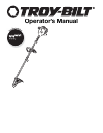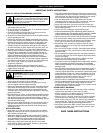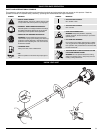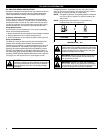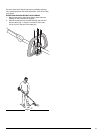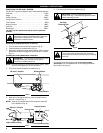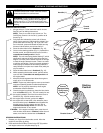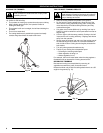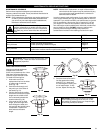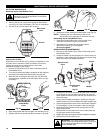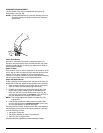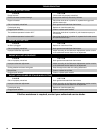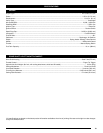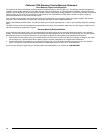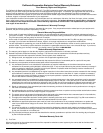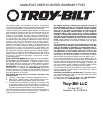
8
TIPS FOR BEST TRIMMING RESULTS
• Keep the cutting attachment parallel to the ground.
• Do not force the cutting attachment. Allow the tip of the
line to do the cutting, especially along walls. Cutting with
more than the tip will reduce cutting efficiency and may
overload the engine.
• Cut grass over 8 inches (200 mm) by working from top to
bottom in small increments to avoid premature line wear or
engine drag.
• Cut from right to left whenever possible. Cutting to the left
improves the unit's cutting efficiency. Clippings are thrown
away from the operator.
• Slowly move the trimmer into and out of the cutting area at
the desired height. Move either in a forward-backward or
side-to-side motion. Cutting shorter lengths produces the
best results.
• Trim only when grass and weeds are dry.
• The life of your cutting line is dependent upon:
— Following the trimming techniques
— What vegetation is being cut
— Where vegetation is cut
For example, the line will wear faster when trimming against a
foundation wall as opposed to trimming around a tree.
HOLDING THE TRIMMER
Before operating the unit, stand in the operating position (Fig.
12). Check for the following:
• The operator is wearing eye protection and proper clothing
• With a slightly-bent right arm, the operator’s hand is
holding the shaft grip
• The operator’s left arm is straight, the left hand holding the
D-handle
• The unit is at waist level
•
The cutting attachment is parallel to the ground and easily
contacts the grass without the need to bend ove
r
Fig. 12
DECORATIVE TRIMMING
Decorative trimming is accomplished by removing all
vegetation around trees, posts, fences and more.
Rotate the whole unit so that the cutting attachment is at a 30°
angle to the ground (Fig. 13).
OPERATING INSTRUCTIONS
CAUTION: Do not remove or alter the line cutting
blade assembly. Excessive line length will make the
clutch overheat. This may lead to serious personal
injury or damage to the unit.
WARNING: Always wear eye, hearing, foot and
body protection to reduce the risk of injury when
operating this unit.
Fig. 13
30°



